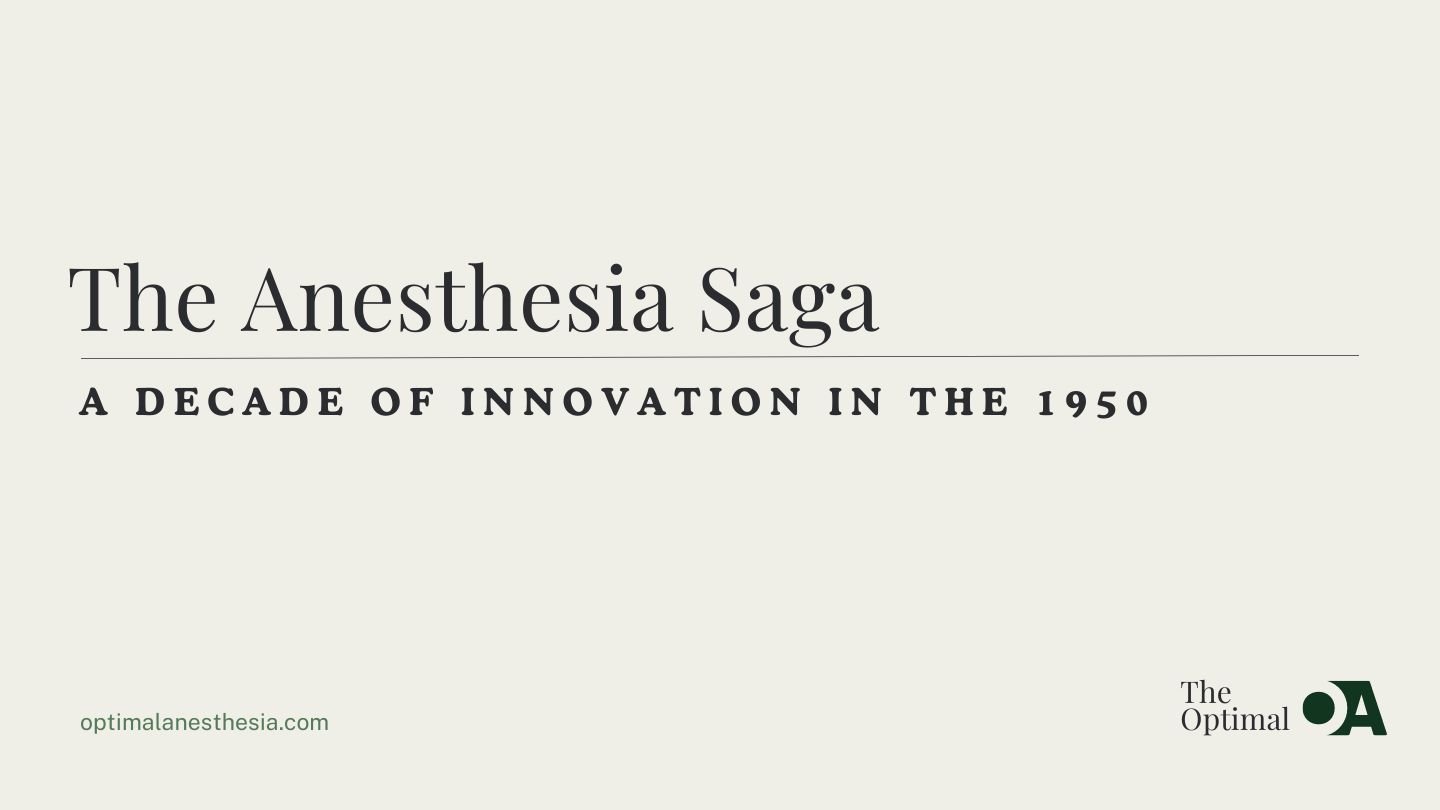The 1950s were a transformative period in the field of anesthesia, marked by significant advancements and the rise of key figures who shaped the specialty. This decade saw the convergence of medical discoveries, technological innovations, and changes in practice that laid the foundation for modern anesthesia techniques.
1950:
- Pain Management: Interest in regional anesthesia declined as new drugs for general anesthesia became available, making general anesthesia more attractive. However, leaders like John Bonica and Daniel Moore continued to emphasize the importance of regional anesthesia, particularly in pain control. This period also saw the development of pain clinics, spearheaded by Bonica, which focused on managing chronic pain through various techniques, including regional anesthesia.
- Veterinary Anesthesia: In veterinary medicine, UK veterinarians Barbara Weaver and Leslie Hall made significant strides by becoming the first veterinarians to practice anesthesia exclusively. They adapted human anesthesia techniques for their animal patients, recognizing the need for specialized anesthesia care in veterinary practice.
- Management of Postoperative Nausea and Vomiting (PONV): The management of PONV saw advancements with the discovery of the antihistamine dramamine. This medication, initially used to treat motion sickness, was repurposed for managing PONV, marking a significant development in postoperative care.
1951:
- A New Rapid and Short-acting Muscle Relaxant: Succinylcholine, a neuromuscular blocking drug with rapid onset and short duration of action, was introduced for clinical use. Its unique properties made it ideal for procedures requiring brief muscle relaxation, such as tracheal intubation.
- Ethical Considerations: Henry Beecher, a prominent anesthesiologist, advocated for the use of placebos in human trials and argued for informed consent for all participants in research studies involving humans. These ethical considerations laid the foundation for modern standards of research ethics and patient consent.
1953:
- Virginia Apgar Scores: Virginia Apgar, a pioneering anesthesiologist, developed the Apgar Score, a standardized method for evaluating the health of newborns immediately after birth. The Apgar Score, based on five criteria, quickly became a standard practice in neonatal care, providing valuable information about the newborn’s condition and guiding subsequent medical interventions.
- Regional Anesthesia Safety: Concerns about the safety of local anesthetics, particularly when delivered to the spinal canal, were addressed by Dripps and Vandam’s study. Their prospective study of 10,098 patients who received spinal anesthesia with tetracaine found no severe neurological problems, supporting the safety and efficacy of regional anesthesia techniques.
1954:
- An Invention of War Becomes One of Peace: The infrared analyzer, initially developed for military purposes during World War II, was repurposed for medical use in the early 1950s. This device, used to measure the concentration of carbon dioxide (CO2) in exhaled breath, became an essential tool in anesthesia practice, allowing for precise monitoring of respiratory function during surgery.
- Chloroprocaine, a New Local Anesthetic: Chloroprocaine, a new local anesthetic, was introduced for clinical use. Despite initial skepticism due to its ester-linked structure, chloroprocaine offered advantages such as rapid degradation by plasma cholinesterase, making it suitable for short procedures where a quick onset and offset of anesthesia were desired.
1955:
- The Birth of the World Federation of Societies of Anaesthesiologists (WFSA): The WFSA was founded in 1955, bringing together anesthesiologists from around the world to promote the advancement of the speciality and facilitate international collaboration. This marked a significant milestone in the global recognition of anesthesiology as a distinct medical speciality.
1956:
- Nitrous Oxide Can Be Lethal: A study by Lassen et al. highlighted the potential dangers of prolonged nitrous oxide inhalation, which could lead to severe bone marrow depression and death. This discovery underscored the importance of the cautious use of nitrous oxide in clinical practice, particularly in patients at risk for complications.
- CRNA: The term “Certified Registered Nurse Anesthetist” (CRNA) came into use in the US, reflecting the growing role of nurses in anesthesia care. CRNAs underwent a year of training in nurse anesthesia, highlighting the increasing recognition of nurses as valuable members of the anesthesia team.
1959:
- Modern Outpatient Anesthesia Begins: Canadian anesthetists Eric Webb and Horace Graves reported their experience with outpatient anesthesia, marking the beginning of modern outpatient anesthesia practice. Their successful outcomes with outpatient surgery paved the way for the expansion of outpatient surgical procedures in the following decades.
- Resusci-Anne: Åsmund Laerdal developed Resusci-Anne, a mannequin used to teach cardiopulmonary resuscitation (CPR). This innovative teaching tool revolutionized CPR training, allowing healthcare providers to practice lifesaving techniques in a realistic simulation environment.
The 1950s were a dynamic period in anesthesia, characterized by significant advancements in pain management, patient safety, and surgical care. Innovations in drugs, techniques, and equipment laid the groundwork for modern anesthesia practices, shaping the speciality into what it is today.


